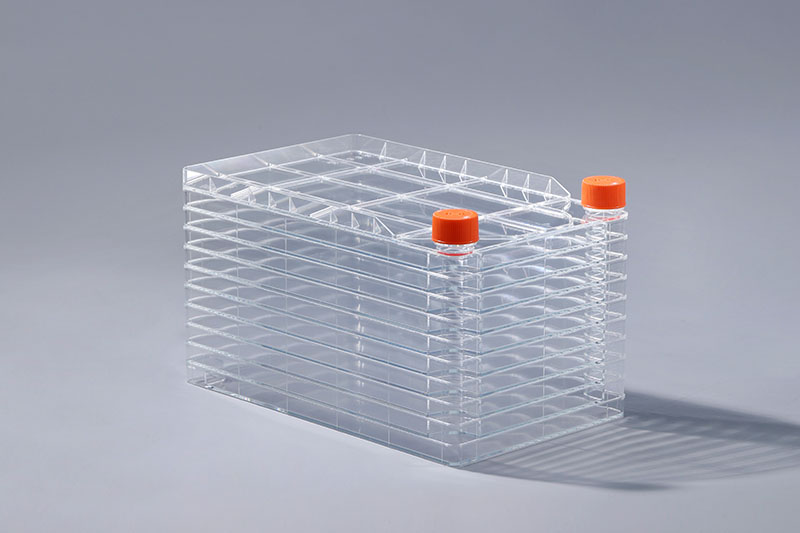Mar chomhábhar inchaite do chultúr na gceall mórscála, tá ról tábhachtach ag cell factories i bhforbairt vacsaíní, i mbithchógaisíocht agus i réimsí eile. Is tasc speisialta é cultúr na gceall. Tar éis gach ullmhúchán a dhéanamh, is gá tuiscint a fháil ar staid fáis na gcealla in am chun coigeartuithe a dhéanamh ar gach obair. 1 ciseal, 2 sraithe, 5 sraitheanna, 10 sraitheanna, agus 40 sraitheanna. Ní mór micreascóp inbhéartaithe a bheith ag féachaint ar staid fáis na gcealla go ginearálta, ach de ghnáth ní bhíonn an ionstraim seo ach oiriúnach chun 1-10 sraith de mhonarchana cille a bhreathnú, agus féadann sé fás 1 agus 2 sraithe a urramú. Ní féidir leis an dara sraith bun ach aonfhoirmeacht a chealla a urramú, agus níl sé oiriúnach le haghaidh daichead ciseal. monarchana cille a bhreathnú. Go ginearálta bíonn lionsaí ag ionstraimí den sórt sin i dhá threoir: breathnóireacht taobh agus breathnóireacht bun. Is féidir leis an gcóras méid cille agus dlús fáis a ríomh, agus is féidir leis staid na gcealla a urramú i ngach sraith de mhonarchana cille. . Má tá an stát fáis cille bocht, feabhsófar imlíne na cille, déanfar an t-innéacs athraonta cille a lagú, beidh folúis, braoiníní lipid agus substaintí gráinneach eile le feiceáil sa cíteaplasma cille, méadóidh an bhearna idir cealla, beidh an cruth neamhrialta. , agus caillfear fiú na cealla bunaidh. Gnéithe, a eascraíonn i crapadh bhabhta agus shedding, agus uaireanta flocs filamentous le feiceáil ar agus timpeall an dromchla cille. Ba chóir go mbeadh na gluaiseachtaí éadrom, seachain turraingí foréigneacha, níor chóir go mbeadh an t-am breathnóireachta ró-fhada, agus níor chóir go mbeadh líon na breathnuithe ró-mhinic, ionas nach gcuirfí isteach ar fhás cille.
Depending on the culture area, the cell factory consists of one or more layers such as 1 layer, 2 layers, 5 layers, 10 layers, and 40 layers. Observing the growth state of cells generally requires an inverted microscope, but this instrument usually only It is suitable for observing 1-10 layers of cell factories, and can observe the growth of 1 and 2 layers. The bottom second layer can only observe the uniformity of its cells, and it is not suitable for forty layers.
If you want to observe the growth state of cells in more layers of cell factories, you need to use microscopes specially designed to observe cell factories. Such instruments generally have lenses in two directions: side observation and bottom observation. The system can calculate the cell size and growth density, and can observe the state of cells in all layers of cell factories.
Cells with good cell growth state can be observed under the microscope with large transparency, strong refraction, and unclear outline. If the cell growth state is poor, the cell outline will be enhanced, the cell refractive index will be weakened, vacuoles, lipid droplets and other granular substances will appear in the cell cytoplasm, the gap between cells will increase, the shape will be irregular, and even the original cells will be lost. Features, resulting in round shrinkage and shedding, and sometimes filamentous flocs appear on and around the cell surface.
When observing the cells in the cell factory, pay attention to the concept of sterility. The movements should be light, avoid violent shocks, the observation time should not be too long, and the number of observations should not be too frequent, so as not to affect the cell growth.
The FAI climbed 5.9 percent year-on-year in the first 11 months of 2018, quickening from the 5.7-percent growth in Jan-Oct, the National Bureau of Statistics (NBS) said Friday in an online statement.
The key indicator of investment, dubbed a major growth driver, hit the bottom in August and has since started to rebound steadily.
In the face of emerging economic challenges home and abroad, China has stepped up efforts to stabilize investment, in particular rolling out measures to motivate private investors and channel funds into infrastructure.
Friday's data showed private investment, accounting for more than 60 percent of the total FAI, expanded by a brisk 8.7 percent.
NBS spokesperson Mao Shengyong said funds into weak economic links registered rapid increases as investment in environmental protection and agriculture jumped 42 percent and 12.5 percent respectively, much faster than the average.
In breakdown, investment in high-tech and equipment manufacturing remained vigorous with 16.1-percent and 11.6-percent increases respectively in the first 11 months. Infrastructure investment gained 3.7 percent, staying flat. Investment in property development rose 9.7 percent, also unchanged.
 English
English



















































